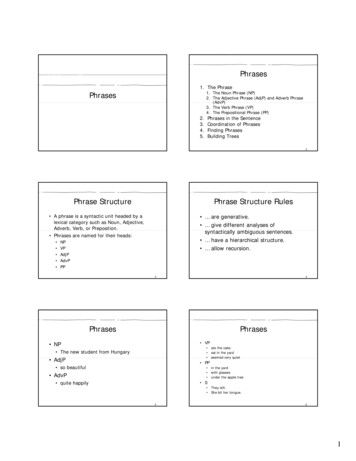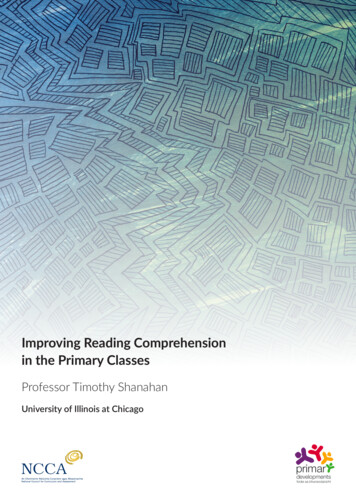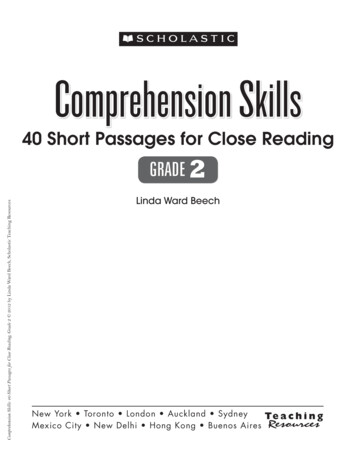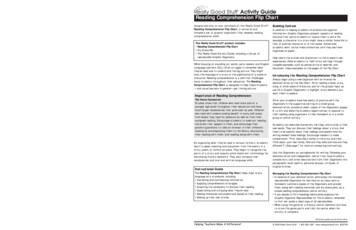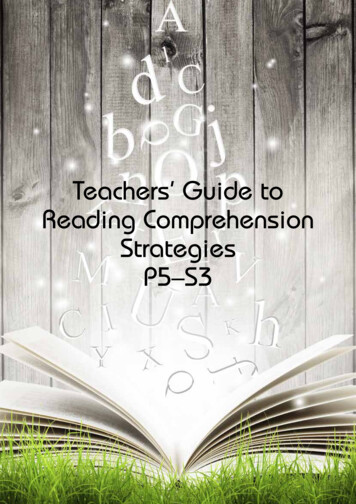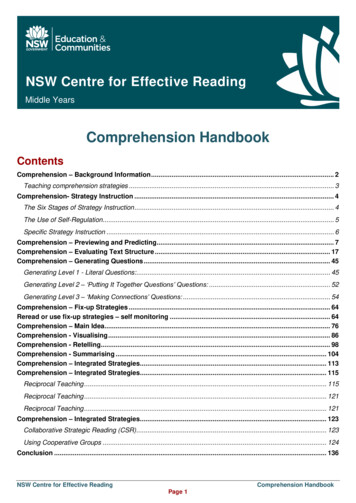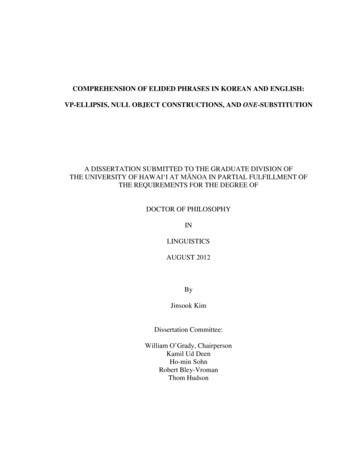
Transcription
COMPREHENSION OF ELIDED PHRASES IN KOREAN AND ENGLISH:VP-ELLIPSIS, NULL OBJECT CONSTRUCTIONS, AND ONE-SUBSTITUTIONA DISSERTATION SUBMITTED TO THE GRADUATE DIVISION OFTHE UNIVERSITY OF HAWAI‘I AT MĀNOA IN PARTIAL FULFILLMENT OFTHE REQUIREMENTS FOR THE DEGREE OFDOCTOR OF PHILOSOPHYINLINGUISTICSAUGUST 2012ByJinsook KimDissertation Committee:William O’Grady, ChairpersonKamil Ud DeenHo-min SohnRobert Bley-VromanThom Hudson
Copyright 2012byJinsook KimAll Rights Reservedi
To my parents,Taewook Kim and Cheolja Lee,with loveii
ACKNOWLEDGEMENTSThis is the moment that I have longed for since beginning this dissertation. I haveleft this section to the last. I am very glad to have the opportunity to express my gratitudeto the many people who have supported me along the way to successful completion. Itwas a great privilege for me to have studied in beautiful Hawai‘i and to have met manygreat faculty, colleagues, and staff throughout my years in graduate school.First and foremost, I would like to express my deepest appreciation and respect tomy academic advisor and dissertation chair, William O’Grady, for his constant supportand encouragement over the years. I cannot thank him enough for his careful, criticalreading, insightful feedback, and wholehearted support. His interest in and enthusiasm forresearch always inspires me to move one step further as a researcher. He has been a trulywonderful role model as a scholar, professor, and advisor.I would also like to extend my gratitude to my dissertation committee. I amgrateful to Kamil Ud Deen, who taught me language acquisition and researchmethodology courses with interest and served on my dissertation committee. He helpedopen my eyes to interesting, burgeoning areas in linguistics. I thank him for spendingconsiderable time on discussing my research topic with me while I was taking LING699.My appreciation also goes to Ho-min Sohn for supporting my dissertation with hisremarkable, profound insight about the Korean language. In particular, I thank him for hiscomments during the defense. Thank you to Robert Bley-Vroman for his sharpobservation and feedback on my dissertation and a working paper. His comments andadvice were very helpful and improved my work considerably. Also, I won’t forget hischeerful lesson on the contra dance during the SLSSA retreat. My sincere gratitude alsoiii
goes to Thom Hudson, who helped me from the first semester of my M.A. program to thelast semester of my Ph.D. program. He supported my research with expert knowledge onstatistics, which was tremendously helpful for my data analysis.I would also like to express my gratitude to the faculty of the LinguisticsDepartment, who provided the precious opportunity for me to expand my capacity undertheir academic guidance. In particular, I thank Amy J. Schafer for her teaching ofpsycholinguistics and research methodology, and for her academic discipline, which wasimmensely helpful and inspiring as I became an independent researcher step by step.My deepest appreciation and respect go to my advisor in Korea, Sung-Kyun Yim,who showed an enormous amount of support and advice throughout the years beginningwith my undergraduate program. I am indebted to him for my academic growth. Hisguidance and encouragement always made me look for the silver lining and moved meforward.This dissertation was made possible through the following financial support: theResearch Corporation of the University of Hawai‘i Graduation Fellowship forDissertation Completion, the AAUW Pacific Fellowship for Research, the Korean HonorScholarship, the Dai Ho Chun Fellowship, the Yŏng-Min Endowment Scholarship, theUniversity of Hawai‘i at Mānoa Department of Linguistics Endowment Fund, theUniversity of Hawai‘i Graduate Student Organization Award, and the Center for KoreanStudies Graduate Scholarship. I am grateful to these organizations for awarding mefellowships to conduct experiments in Korea and the States, and to write my dissertation.I also thank the Center for Korean Studies at the University of Hawai‘i at Mānoa forsupporting me to work as a library research assistant throughout my studies in Hawai‘i.iv
For my dissertation project, a number of people helped me collect data in Koreaand the States. Without their support, my dissertation would not have been possible. Mydeep gratitude goes to Professors Sun-Hye Hwang, In-Chan Park, Sechang Lee, HyunSook Shin, Hee-Don Ahn, Moongee Jeon, Sook-Hwan Cho, Jeong-Taek Lee, Jae-SungLee, Keon-Sook Park, and Brandy Frazier. Also, I express my appreciation to Eun YeopOh, Jeong Yoon Chang, Jake Terrell, and Dewayne Bettag for their help with datacollection. My appreciation also goes to Joyce Hildebrand for her professional editorialsupport to improve this work.I would like to extend my sincere thanks to Dr. Michael MacMillan for histremendous consideration and assistance while I was working at the Center for KoreanStudies. I was very blessed to meet him and to have him as my supervisor at work. Hetrusted me, understood my situation, and ceaselessly encouraged me to complete all theprocedures successfully. Whenever I designed my experiments, he was always willing tobe my first subject for pilot studies and to provide me with English native speakers’intuitions about ambiguous sentences. I thank him for his patience and comments. I alsoappreciate his fulfilling the promise of “Chef Mavro” upon my completion.I would like to express my special thanks to Professor Sang Yee Cheon for herwholehearted support and sincere sisterhood in God. She always cares for me like herown sister and gives precious advice. She was, in fact, the person who helped me majorin linguistics in Hawai‘i; she was also one of the most influential people during my study.I owe significant thanks to her.My sincere thanks go to Pastor David Kim and Mrs. Tiffany Kim at All NationsFellowship in Hawai‘i for their love, encouragement, devotion, and prayers. I alsov
express my gratitude to my fellow church members. I would especially like to thank thedeaconesses (Kwensanim) Youngja Ahn, Kyuja Kim, Youngsook Lee, Wonja Kwon, andJeongsook Moon for their loving hearts and considerate care. I won’t forget theirdevotion to the 9th Floor Church and the Salt Lake Church. My sincere appreciation alsogoes to Myosin Kim for her sisterhood in God. I am deeply indebted to Myosin for hergenerous, giving heart and for my spiritual growth. Thanks to her prayers, advice, andloving discipline, I could walk in the favor of God in the wilderness.I am also exceedingly grateful to Mrs. Duk-Hee Lee Murabayashi and Hee JeongJeong for our friendships, which cross the generation gap. Our monthly Pho (laterShabushabu) meeting always made me feel invigorated. I particularly appreciate Mrs.Duk-Hee Lee Murabayashi for providing her gourmet homegrown mangoes andavocadoes over the years.A big thank you to my fellow students and colleagues at the University of Hawai‘i:Jung-Hee Kim, Hye-Young Kwak, Heeyeon Yoon Dennison, Soyoung Kim, Tsai-HsiuDorinda Liu, Manami Sato, Apay Tracy Tang, Sangseok Yoon: thank you for your mutualencouragement and for sharing your time, knowledge, and hearts during my doctoral study.Heartfelt thanks also go to Sumi Chang-Han for her thoughtful consideration, warm heart,and constant friendship throughout my years in graduate study. My thanks to Sang-GuKang, On-Soon Lee, Jinsun Choe, Chae Eun Kim, Kum Jeong Joo, Sunju Kim, JonnyKim, Hyeyeon Kim, Kitaek Kim, Hunter Hatfield, Toshiaki Furukawa, Nian Liu, ElaineLau, Kanjana Thepboriruk, and Nozomi Tanaka for sharing fellowship. I am also gratefulto all the faculty and friends in the Language Acquisition Meeting for providinginvaluable comments, sharing ideas, and inspiring me with enthusiasm for research.vi
I thank our department staff, Jennifer Kanda and Nora Lum for their wonderfuland prompt administrative assistance throughout my doctoral study. My appreciationgoes to the program coordinator of the University of Hawai‘i at Mānoa Center for KoreanStudies, Brandie H. Chun, for her support and generous understanding. I am also gratefulto the University of Hawai‘i at Mānoa Center for Korean Studies library researchassistants, Heui-Yung Park and Hye Jeong Kwon, for their faithfulness and heartfeltfellowship.I reserve my final thanks for my family. The loving support of my parents,Taewook Kim and Cheolja Lee, has nurtured me and strengthened me to overcome alladversity. Thanks to their constant prayers, loving encouragement, and trust, I havecompleted the doctoral program with joy. I have the deepest gratitude for everything youhave done for me to make this possible. I would also like to thank my eldest sister andbrother-in-law, Namsuk Kim and Jinsoo Jeon, for their thoughtful care andencouragement, and my brother and sister-in-law, Gu Hwan Kim and Jeong Hee Yoon,for their constant support and help. My appreciation goes as well to my second eldestsister and brother-in-law, Jeong Sook Kim and Samuel Kim, for their constant prayers; tomy cousins, In Hye Lee and In Sung Lee, for their concern; and to my lovely nephewsand niece, Alvin Sungmin Jeon, Hyun Seung Kim, and Ka Yoon Kim, for constantlyproviding me with positive energy.I thank God, who has guided me to experience this journey with pleasure. I giveall honor, glory, and praise to God.vii
ABSTRACTThe purpose of this study is to experimentally investigate the comprehension ofelided phrases in Korean and English, focusing on the patterns exemplified below.(1) Koreana. VP-ellipsis:Sungki-kaphalan kabang-ul sa-ss-e-yo.Sunhuy-to-yey-yoSungki-NOM bluebag-ACC buy-PST-DECL-POL Sunhuy-also-be-POL‘Sungki bought a blue bag. Sunhuy did too.’b. Null object construction:Sungki-kaphalan kabang-ul sa-ss-e-yo.Sungki-NOM bluebag-ACC buy-PST-DECL-POLSunhuy-tosa-ss-e-yo.Sunhuy-also buy-PST-DECL-POL‘(lit.) Sungki bought a blue bag. Sunhuy bought too.’(2) Englisha. VP-ellipsis:John bought a blue bag. Mary did too.b. One-substitution:John bought a blue bag. Mary bought one too.The results of this study reveal that Korean L1 speakers interpreted Korean VPellipsis by taking the entire VP in the first clause to be the antecedent of the elided VP inthe second clause. For the null object construction, they comprehended the null argumentin the second clause with the help of the antecedent clause rather than contextualinformation.With respect to recovery of adverbial modifiers, when an antecedent clausecontained a modifier phrase denoting manner, reason, time, or location, Korean L1speakers recovered the modifier phrase at the elided site in VP-ellipsis regardless ofmodifier type. For the null object construction, many of them recovered temporal andviii
locative modifier phrases as null arguments in the second clause, whereas they tended notto recover manner and reason modifier phrases in the second clause.Similarly, Korean L2 learners of English and English L1 speakers interpretedEnglish VP-ellipsis by reconstructing the entire VP of the first clause at the elided site inthe second clause. In addition, they interpreted the pronoun one in English onesubstitution, as in (2b), as referring to the higher N’ (i.e., blue bag), rather than the lowerN’ (i.e., bag).Parallel to the recovery of modifier phrases in Korean VP-ellipsis and the nullobject construction, Korean L2 learners of English and English L1 speakers showed thesame interpretive preference patterns in recovering manner, reason, locative, andtemporal modifier phrases in English VP-ellipsis and one-substitution.The results of this study provide empirical evidence that VP-ellipsis is differentfrom the null object construction. Moreover, based on comprehenders’ different recoverypatterns of modifier phrases in the null object construction and one-substitution patterns,I suggest that the recovery of modifier phrases is sensitive to the verb’s event structure(Davidson 1980), independent of syntactic structure.ix
TABLE OF CONTENTSACKNOWLEDGEMENTS . iiiABSTRACT . . .viiiTABLE OF CONTENTS . . .xLIST OF TABLES . . .xiiiLIST OF FIGURES . . . . . . .xvLIST OF ABBREVIATIONS . . .xviiCHAPTER 1 INTRODUCTION . 11.1 General objectives of the dissertation . 11.2 Framework of the dissertation . 61.3 Organization of the dissertation . 7CHAPTER 2 THEORETICAL BACKGROUND . 102.1 Deep and surface anaphora . 102.2 VP-ellipsis . 122.2.1 Syntactic approach to VP-ellipsis . 132.2.2 Semantic approach to VP-ellipsis . 172.3 The null object construction. 202.4 One-substitution . 21CHAPTER 3 RECONSTRUCTION OF NULL ARGUMENTS IN VP-ELLIPSISAND THE NULL OBJECT CONSTRUCTIONS IN KOREAN . 243.1 Previous studies on VP-ellipsis and null object constructions. 243.2 Reconstruction of null arguments in elliptical constructions . 293.3 The present study: Research questions for Experiment 1 . 323.4 Experiment 1 . 343.4.1 Method . 343.4.1.1 Participants . 343.4.1.2 Procedure . 353.4.1.3 Material . 353.4.2 Predictions. 393.4.3 Results . 443.4.4 Discussion of Experiment 1 . 46CHAPTER 4 RECONSTRUCTION OF MODIFIERS IN KOREAN VP-ELLIPSISAND THE NULL OBJECT CONSTRUCTION . 534.1 Previous studies . 534.2 The present study: Research questions for Experiment 2 . 574.3 Experiment 2a . 594.3.1 Method . 614.3.1.1 Participants . 614.3.1.2 Procedure . 62x
4.3.1.3 Material . 624.3.2 Predictions. 664.3.3 Results . 704.3.4 Discussion of Experiment 2a . 754.4 Experiment 2b . 804.4.1 Method . 824.4.1.1 Participants . 824.4.1.2 Procedure . 824.4.1.3 Material . 834.4.2 Predictions. 864.4.3 Results . 874.4.4 Discussion of Experiment 2b . 924.5 General discussion of Experiments 2a and 2b . 96CHAPTER 5 COMPREHENSION OF VP-ELLIPSIS AND ONE-SUBSTITUTIONIN L2 ENGLISH . 995.1 Previous studies on elliptical constructions in L2 acquisition . 995.2 The present study . 1055.3 Research questions for Experiment 3 . 1075.4 Experiment 3 . 1085.4.1 Method . 1085.4.1.1 Participants . 1085.4.1.2 Procedure . 1095.4.1.3 Material . 1105.4.2 Results . 1125.4.3 Discussion of Experiment 3 . 1155.5 Research questions for Experiment 4 . 1205.6 Experiment 4a . 1215.6.1 Method . 1225.6.1.1Participants . 1225.6.1.2 Procedure . 1235.6.1.3 Material . 1245.6.2 Results . 1265.6.3 Discussion of Experiment 4a . 1335.7 Experiment 4b . 1365.7.1 Method . 1375.7.1.2 Participants . 1375.7.1.2 Procedure . 1385.7.1.3 Material . 1385.7.2 Results . 1405.7.3 Discussion of Experiment 4b . 1475.8 General discussion of Experiment 3 and Experiment 4 . 150CHAPTER 6 CONCLUSION . 154xi
6.16.26.36.4Summary of the major findings and implications . 154Contributions of this study . 160Suggestions for future research . 163Concluding remarks . 165APPENDIX AAPPENDIX BAPPENDIX CAPPENDIX DAPPENDIX EAPPENDIX FAPPENDIX GTest sentences used in experiment 1 . 167Test sentences used in experiment 2 . 168Filler sentences used in Experiments 1 and 2 . 170Test sentences used in experiment 3 . 171Test sentences used in experiment 4 . 172Filler sentences used in experiments 3 and 4 . 174Cloze test . 175REFERENCES . 179xii
LIST OF TABLESTable 3.1 Predictions of null argument reconstruction in Korean VP-ellipsis and nullobject constructions . 39Table 3.2 Mean proportion of ‘YES’ responses to target sentences in Experiment 1 . 44Table 4.1 Recovery of modifiers in VP-ellipsis and null object constructions . 53Table 4.2 Experimental conditions for each questionnaire . 62Table 4.3 Predictions of manner and locative modifier recovery in Korean VP-ellipsisand null object constructions . 66Table 4.4 Mean proportion of ‘YES’ responses to target sentences in Experiment 2a(manner – locative modifiers) . 71Table 4.5 Tests of within-subjects contrasts in Experiment 2b. 73Table 4.6 Experimental conditions for each questionnaire in Experiment 2b . 83Table 4.7 Predictions of reason and temporal modifier recovery in Korean VP-ellipsisand the null object construction . 86Table 4.8 Mean proportion of ‘YES’ responses to target sentences in Experiment 2b(reason – temporal modifier) . 87Table 4.9 Tests of within-subjects contrasts in Experiment 2b. 89Table 5.1 Summary of Experiment 3 participants’ background information . 109Table 5.2 Mean proportion of ‘YES’ responses to target sentences in Experiment 3 . 112Table 5.3 Tests of between-subjects effects in Experiment 3 . 114Table 5.4 Summary of participants’ background information . 123Table 5.5 Experimental conditions for each questionnaire for Experiment 4a . 124Table 5.6 Mean proportion of ‘YES’ responses to target sentences in Experiment 4a(English L1 speakers: manner–locative) . 127Table 5.7 Mean proportion of ‘YES’ responses to target sentences in Experiment 4a(Korean L2 learners: manner–locative) . 129xiii
Table 5.8 Summary of Experiment 4b participants’ background information . 138Table 5.9 Experimental conditions for each questionnaire for Experiment 4b . 139Table 5.10 Mean proportion of ‘YES’ responses to target sentences in Experiment 4b(English L1 speakers: reason–temporal) . 141Table 5.11 Mean proportion of ‘YES’ responses to target sentences in Experiment 4b(Korean L2 learners: reason–temporal) . 142xiv
LIST OF FIGURESFigure 3.1 Korean L1 speakers’ responses to VP-ellipsis and the null object constructionin Experiment 1 . 44Figure 4.1 Recovery of manner and locative modifier phrases in VP-ellipsis and the nullobject construction by Korean L1 speakers in Experiment 2a . 71Figure 4.2 The number of Korean L1 speakers who answered ‘TRUE’ to the null objectconstruction containing a manner or a locative modifier in the non-parallel contextcondition in Experiment 2a . 74Figure 4.3 Recovery of reason and temporal modifier phrases in VP-ellipsis and the nullobject construction by Korean L1 speakers in Experiment 2b . 87Figure 4.4 The number of Korean L1 speakers who answered ‘TRUE’ to the null objectconstruction containing a reason or a temporal modifier in the non-parallel contextcondition in Experiment 2b . 90Figure 5.1 Comprehension of VP-ellipsis and one-substitution by Korean L2 speakersand English L1 speakers in Experiment 3. 112Figure 5.2 The number of Korean L2 learners of English who answered ‘TRUE’ to onesubstitution in the color-mismatch context condition in Experiment 3 . 114Figure 5.3 Recovery of manner and locative modifier phrases in VP-ellipsis and onesubstitution by English L1 speakers in Experiment 4a . 127Figure 5.4 Recovery of manner and locative modifier phrases in VP-ellipsis and onesubstitution by Korean L2 learners of English in Experiment 4a . 129Figure 5.5 The number of English speakers who answered ‘TRUE’ to one-substitutioncontaining a manner or a locative modifier in the non-parallel context condition inExperiment 4a . 131Figure 5.6 The number of Korean L2 learners of English who answered ‘TRUE’ to onesubstitution containing a manner or a locative modifier in the non-parallel contextcondition in Experiment 4a . 132Figure 5.7 Recovery of reason and temporal modifier phrases in VP-ellipsis and onesubstitution by English L1 speakers in Experiment 4b . 141Figure 5.8 Recovery of reason and temporal modifier phrases in VP-ellipsis and onesubstitution by Korean L2 learners of English in Experiment 4b . 143xv
Figure 5.9 English L1 speakers’ and Korean L2 learners’ reconstruction of reason andtemporal modifier phrases in one-substitution in the non-parallel context condition inExperiment 4b . 144Figure 5.10 The number of English L1 speakers who answered ‘TRUE’ to onesubstitution containing a reason or a temporal modifier in the non-parallel contextcondition in Experiment 4b . 145Figure 5.11 The number of Korean L2 learners of English who answered ‘TRUE’ to onesubstitution containing a reason or a temporal modifier in the non-parallel contextcondition in Experiment 4b . 146xvi
LIST OF ABBREVIATIONSACCAccusative case particleCLClassifierDECLDeclarative sentence-type suffixGENGenitive particleNOMNominative case particlePOLPolite speech level, suffix, or particlePSTPast tense suffixTOPTopic particlexvii
CHAPTER 1INTRODUCTION1.1General objectives of the dissertationSpeakers often omit material that has been mentioned in the previous discoursewhen listeners can easily retrieve what is omitted, as in (1):(1) Englisha. John ate an apple and Bill did too.b. John ate an apple and Bill ate an apple too.The second conjunct in (1a) is phonetically presented as Bill did too, but it is interpretedas ‘Bill ate an apple too.’ In (1b), the verb phrase ate an apple appears in both the firstand the second conjuncts, but for the sake of economy of communication, such phrasesare often omitted from the second conjunct, creatin
Parallel to the recovery of modifier phrases in Korean VP-ellipsis and the null object construction, Korean L2 learners of English and English L1 speakers showed the same interpretive preference patterns in recovering manner, reason, locative, and temporal modifier phra
